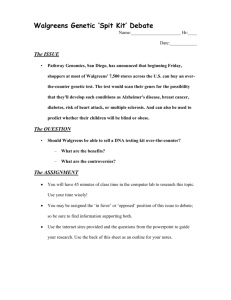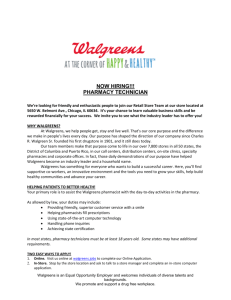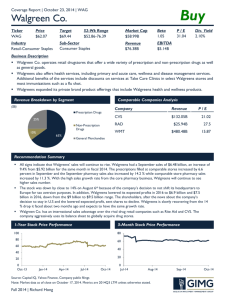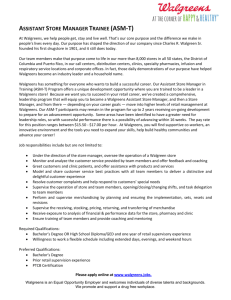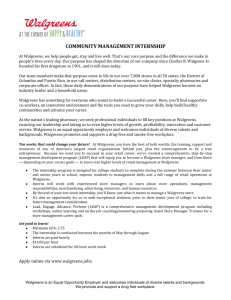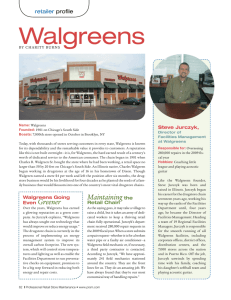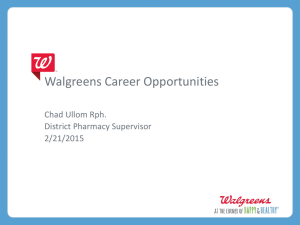Ferguson, James
advertisement
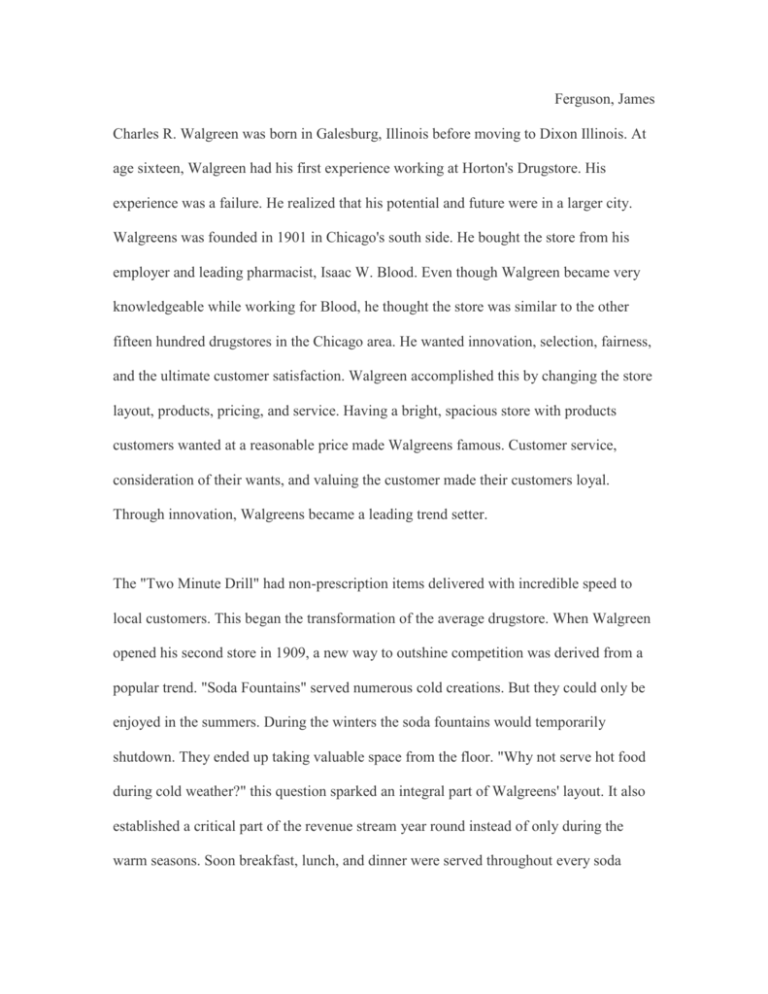
Ferguson, James Charles R. Walgreen was born in Galesburg, Illinois before moving to Dixon Illinois. At age sixteen, Walgreen had his first experience working at Horton's Drugstore. His experience was a failure. He realized that his potential and future were in a larger city. Walgreens was founded in 1901 in Chicago's south side. He bought the store from his employer and leading pharmacist, Isaac W. Blood. Even though Walgreen became very knowledgeable while working for Blood, he thought the store was similar to the other fifteen hundred drugstores in the Chicago area. He wanted innovation, selection, fairness, and the ultimate customer satisfaction. Walgreen accomplished this by changing the store layout, products, pricing, and service. Having a bright, spacious store with products customers wanted at a reasonable price made Walgreens famous. Customer service, consideration of their wants, and valuing the customer made their customers loyal. Through innovation, Walgreens became a leading trend setter. The "Two Minute Drill" had non-prescription items delivered with incredible speed to local customers. This began the transformation of the average drugstore. When Walgreen opened his second store in 1909, a new way to outshine competition was derived from a popular trend. "Soda Fountains" served numerous cold creations. But they could only be enjoyed in the summers. During the winters the soda fountains would temporarily shutdown. They ended up taking valuable space from the floor. "Why not serve hot food during cold weather?" this question sparked an integral part of Walgreens' layout. It also established a critical part of the revenue stream year round instead of only during the warm seasons. Soon breakfast, lunch, and dinner were served throughout every soda fountain in Walgreens until the 1980's. When the ninth store opened in 1916, the stores incorporated to form Walgreens Corporation. By 1920, there were twenty strong Walgreens Drugstores throughout the greater Chicago area. Practicing what he preached, Walgreen's innovation, selection, fairness, and ultimate customer satisfaction laid foundation for a nation wide drugstore chain. 1922 brought the creation of the malted milkshake. Before, there was only a malted milk beverage. This innovation led way for the phenomenal growth that would take place that decade. In 1929, Walgreens' stores reached five hundred twenty-five. The stores spread to New York, Florida, and other major markets making Walgreens not only a place to shop but a social hotspot. In 1927, Walgreens went public. While the Great Depression affected the economy as well as other businesses, Walgreens persevered. Thriving on its foundation and innovative thinking, Walgreens strived to reach new heights. Having consistent sales growth each year allowed Walgreens to be able to tremendously advertise; by having the biggest advertisers in Chicago and other parts of the country as well as being the first drugstore to advertise on the radio wit legendary Chicago Cubs announcer Bob Elson the "voice" of Walgreens, invest in state-of-the-art buildings for their growing research and manufacturing laboratory with additional space to manufacture its popular candy line, and create foundations such as the Charles R Walgreen Foundation for the Study of American Institutions during this period. As Walgreens emerged from the Great Depression victorious in 1939, Charles R Walgreen, Sr. died at the age of sixty-six. He left his company in superb condition. Walgreen also shaped and prepared his son Charles Walgreen Jr. to take over and lead Walgreens into the future. Today, Walgreens' headquarters is located in Deerfield, Illinois, just north of Chicago where it was founded. There are over sixty-five hundred stores across the country and Puerto Rico that serve five million three hundred thousand people daily. Leading the chain drugstore industry in sales and profit, Walgreens serves over twenty thousand products through their twenty-four hour a day stores, one hour photo shops, and drivethru pharmacies. Walgreens' completion is CVS and Rite Aid which respectively have one half and one third of sales. This wide range of products started in 1950 when the transition to self-service drugstores began. Even though the expansion brought more products than ever before, more employees were needed to be hired because of the stores' size. This allowed Walgreens to raise the level of their customer service which is the face of the company. Looking deeper into the company, Walgreens likes to promote from within. It is an internal strength that most of the people who work in the corporate office began working in the retail side of the company first. Being exposed to the many different areas of the business is beneficial. Knowing all the aspects of a salesperson, pharmacist, and manager develops a strong basis and understanding when reaching a new position. If a person, by chance, does make it to the corporate offices without rising through the ranks, they are sure to participate in all developmental aspects of the company. Development of the operations people is very critical. They need to understand the strong segments of the company. Each region of the country is given to a senior Vice President in the operations department. The next two lower levels are the operations vice president and the district managers who are responsible for roughly 250 and 25 stores respectively. The same organizational structure applies to the pharmaceutical side of the store. Store managers' jobs are to maintain a sense of family throughout the store. It is key for the store managers to bridge the gap concerning employees, merchandising, and customer service to the operations executives. Another strength is Walgreens' technology. Their innovation led to many of today's standards such as non-English prescription drug labels and childresistant prescription containers. Through a partnership with Hewett Packard and its Snapfish technology, Walgreens developed a convenient, innovative, technological, system that allows photos to be uploaded at a personal computer and printed at a Walgreens location. Finally, Walgreens has made a name for itself. It leads the nation's drugstores in sales, earnings growth, same store sales increases, prescription drug market share, and prescription sales per store. Walgreens has established itself as a known and trusted brand name across the country. A weakness that Walgreens suffers is two fold. Even though they grow through acquisitions, they prefer to start from the ground up. This ultimately slows their growth rate. Also, when moving into a new market, the run the risk of driving mom and pop shops out of business. This could have a negative effect on the community. Another weakness is large discounters such as Wal-Mart and Target. They are able to cut generic prescription drugs' price because they can make up for the loss in other categories. Being Walgreens is not the low-cost leader, they are unable to compete in price. They face competition from these large discounters. Finally, Walgreens is getting away from its basis. They are getting caught up in the other aspects of the store. Walgreens is forgetting about their top product. Prescription drugs are being covered up by impulse buys and seasonal items. Instead of making an in and out experience, the customer tends to browse. Therefore, the customer may begin looking elsewhere for a convenient purchase. Looking outside Walgreens lays many opportunities. A major opportunity is the American population. The Baby Boomer generation is getting older. There will be a greater market to target. The aging generation will have difficulties adjusting to the size of supercenters. They will begin looking for the convenience of a name they trust. Another opportunity would be to increase the amount of generic drugs Walgreens carries. Appealing to Baby Boomers who want a name brand from a store they can trust. This will satisfy the thriftiest shopper. Finally, opportunity lies in the international market. Every store will soon have a pharmacy. Some open twenty-four hours a day. International markets provide a great opportunity to expand and find a new customer base. There are numerous threats that Walgreens should be concerned with. Not only are large discounters competing with Walgreens for customers, regular grocery stores are too. It will be very tempting for a customer to fill their prescription while grocery shopping. Walgreens cannot compete with how many different products grocery store as well as discounter stores carry. Another threat is the aging of the Baby Boomer. They do provide a growing market, but at the same time will the economy support it? A lot of Medicaid might be cut because of the vast number. The next threat would be internet shoppers. Many countries sell prescription medicines online at a dramatically cheaper price than in the United States. Finally, there is a major shortage in pharmacist. There are simply not enough to go around. Pharmacists are the main core of Walgreens companies. This will leave Walgreens understaffed in their most critical area. This will be very detrimental to the company's customer convenience. The reason I chose this company is because I read about the success of the company in a book a couple of years ago. The book was called Good to Great. The book Good to Great relates to Walgreens because the company was classified as having a hedgehog concept. This is why the company is amongst the top twenty-five ever created. It knew that its niche was conveniently giving prescription drugs to customers with great customer service. However, as time went on, Walgreens went further away from this concept. They started to focus customers to other parts of their store. It made customers browse, but it also drove them away. The book was written in 2001. Walgreens needs to get back to their hedgehog concept first. Secondly, they need to focus on drawing customers to the other parts of their store. When talking to employees at different Walgreens around the bay area, they were somewhat reluctant to give any of the company’s information away. After explaining my project and what I needed from them, the employees seemed to lighten up a little. People working at Walgreens actually say it is like a family. Sure they have certain employees come and go, but there are those who stay and form bonds amongst each other. These employees usually stay for a couple of years before either leaving the company or moving up to a higher position within the company. A certain employee that is in a higher position says, “The longer you are with the company, the more the company takes care of you. If you work hard, they will reward you. If you do your best for them, they will make sure you are taken care of.” This seems to follow what the company has always been about. What you put into the job is exactly what you get out of it. At times, the future may not seem bright for Walgreens. According to those who notice they did not meet their quarterly expectations. This is not a concern for the company. They are focused on long-term growth as oppose to short term profit. Their commitment to patience allows for their long-term strategy to be implemented. While opening at least one new store each day, hopes of reaching seven thousand stores by 2010 looks very feasible for the company. Acquisitions of Take Care Health will put clinics in Walgreens stores across the country. These clinics bring everyday healthcare to your neighborhood drugstore. Establishing an aggressive strategy to grow but carefully consider Grade A real estate and high-tech excellence allows Walgreens to keep a positive cash flow. Creating the new generation of distribution centers will create efficient as well as responsive supply chains. Getting back to the tradition that Walgreen set himself such as; innovation, selection, fairness, and the ultimate customer satisfaction. Walgreens' future can be unparallel to any other drugstore.
